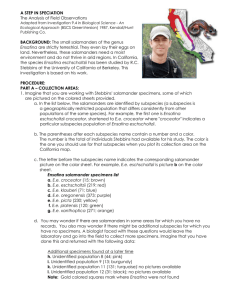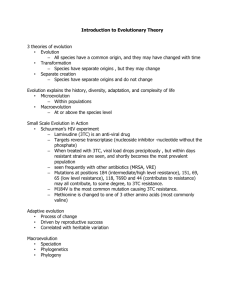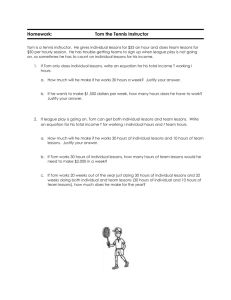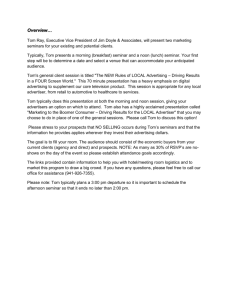A closer look at a classic ring species: The work of Tom Devitt
advertisement
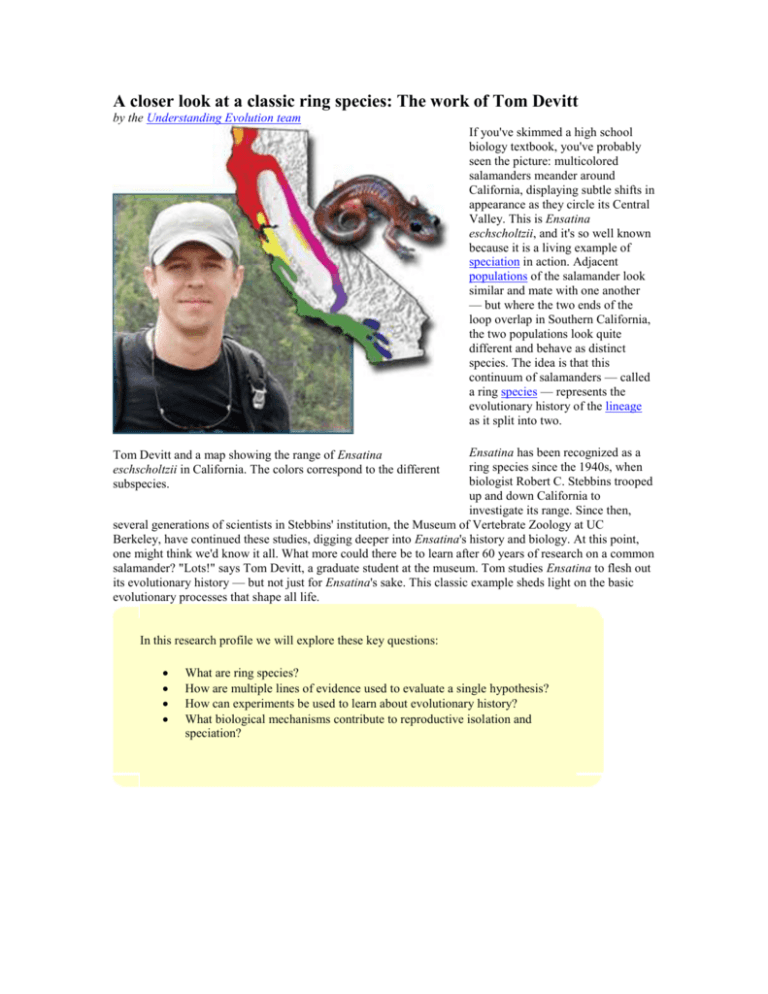
A closer look at a classic ring species: The work of Tom Devitt by the Understanding Evolution team If you've skimmed a high school biology textbook, you've probably seen the picture: multicolored salamanders meander around California, displaying subtle shifts in appearance as they circle its Central Valley. This is Ensatina eschscholtzii, and it's so well known because it is a living example of speciation in action. Adjacent populations of the salamander look similar and mate with one another — but where the two ends of the loop overlap in Southern California, the two populations look quite different and behave as distinct species. The idea is that this continuum of salamanders — called a ring species — represents the evolutionary history of the lineage as it split into two. Ensatina has been recognized as a ring species since the 1940s, when biologist Robert C. Stebbins trooped up and down California to investigate its range. Since then, several generations of scientists in Stebbins' institution, the Museum of Vertebrate Zoology at UC Berkeley, have continued these studies, digging deeper into Ensatina's history and biology. At this point, one might think we'd know it all. What more could there be to learn after 60 years of research on a common salamander? "Lots!" says Tom Devitt, a graduate student at the museum. Tom studies Ensatina to flesh out its evolutionary history — but not just for Ensatina's sake. This classic example sheds light on the basic evolutionary processes that shape all life. Tom Devitt and a map showing the range of Ensatina eschscholtzii in California. The colors correspond to the different subspecies. In this research profile we will explore these key questions: What are ring species? How are multiple lines of evidence used to evaluate a single hypothesis? How can experiments be used to learn about evolutionary history? What biological mechanisms contribute to reproductive isolation and speciation? Discovering a ring species Ensatina's basic story was laid out by Robert Stebbins 30 years before Tom was born in 1977. Based on the ring-like distribution of the different forms, Robert had proposed that the species started off in Northern California and Oregon and then spread south along both sides of the Central Valley, which was too dry and hot for salamanders.1 According to Robert's hypothesis, as the pioneering populations moved south, they evolved into several subspecies with new color patterns and adaptations for living in different environments. By the time they met again in Southern California as the subspecies eschscholtzii and klauberi, he argued, they had each evolved so much that they no longer interbred — even though the subspecies blended into one another around the rest of the ring. Since species are often defined by their inability to interbreed with other species, Ensatina seemed to represent the whole process of speciation — all the gradual changes that accumulate in two lineages and that wind up making them incompatible with one another. Robert Stebbins examining an Ensatina salamander in 1951. Of course, since this all would have happened millions of years ago, Robert wasn't around to observe any of it. He based his ideas on the morphology, or body form, of the subspecies — in this case, their color patterns. First, neighboring subspecies were more similar to one another than to those across the ring and seemed to blend into one another. From this, he hypothesized that Ensatina represented a ring species. Robert also noticed that the northern coastal form, called picta, had a pattern of colors that seemed to encompass the other subspecies. It was easy to imagine how the more specialized southern forms could have evolved from picta. Based on this, Robert hypothesized that the two southward-moving Ensatina lineages had both emerged from picta's immediate ancestors. The subspecies Ensatina eschscholtzii picta. The molecules support the morphology By the 1980s, when Tom was splashing in a pond by his house catching the frogs, snakes, and salamanders that he's always loved, biologists had moved beyond Ensatina's morphology. New tools allowed researchers2 to study the salamanders' proteins, the chemical building blocks of life — and what they found supported Robert Stebbins' ideas. Even though eschscholtzii and klauberi live in the same places in Southern California, their proteins are quite different from one another and each is more biochemically similar to its northern neighbor. This is exactly what we'd expect to observe if these two subspecies represent the endpoints of the ring species. Furthermore, populations of picta had great variety in their proteins — and that's typically what we observe in populations that have been established for a long time and have had plenty of time to accumulate mutations. This observation supported the idea that picta's immediate ancestors gave rise to the whole ring species. By the 1990s, when Tom was in high school considering a career in biology, technology had progressed even further. Scientists could now study the sequence of DNA inside mitochondria — the cellular organelles that help power cells. Ensatina's mitochondrial DNA3 showed the same patterns as their proteins: the northern salamander lineages had the greatest variety of sequences, suggesting that Ensatina got its start in the north and moved south through California. Biologists also used mitochondrial DNA sequences to try to figure out the family tree for all the salamander subspecies. They found that the northern salamander lineages branched off near the base of that family tree — suggesting that they are closely related to the ancestor of the ring. The forms near the eastern and western endpoints of the ring formed distinct clans—just as we'd expect if they each evolved separately from Ensatina's ancestor, as proposed by Robert. Ensatina phylogeny based on mitochondrial DNA. Notice that oregonensis is composed of four separate evolutionary lineages, which happen to be morphologically similar to one another. Similarly, platensis is made up of two distinct lineages. In this case, Ensatina's DNA reveals distinct evolutionary histories that morphology alone did not. Digging into DNA When Tom became intrigued by Ensatina as a graduate student in 2004, he wasn't sure he'd be able to find an unanswered question to work on: "I knew that people had worked on Ensatina for a long time and so I wasn't sure that there was enough room or that there was much left to do with it — until I started talking to people and reading more papers." He realized that there were still gaps in our knowledge and that understanding Ensatina's basic story would allow him to ask deeper questions about their evolution. First, though, Tom and his colleagues wanted to test Ensatina's basic evolutionary story against a new line of evidence: the DNA inside the nucleus, which encodes most of an organism's traits. One might wonder, why bother? After all, Robert Stebbins' original hypothesis had already been supported by studies of the salamanders' morphology, proteins, and mitochondrial DNA. But scientists do their best to evaluate their hypotheses against as many different lines of evidence as is possible and practical. These new lines of evidence don't always overturn our ideas — but they do often help refine and add detail to existing hypotheses. Besides, in the late 1990s a graduate student at Berkeley had collected some additional mitochondrial DNA sequences and had interpreted their history differently.4 Perhaps, he argued, the species got its start south of San Francisco. Another line of evidence might help resolve the issue and clarify the relationships between the subspecies. Gene hunting If Robert Stebbins' original hypothesis is right, sequence data from Ensatina's nuclear DNA should show the same patterns as its mitochondrial DNA, with the most diversity in the north and big genetic differences distinguishing the southernmost lineages. Furthermore, the evolutionary tree based on these DNA sequences should be consistent with a northern origin and southward diversification. Tom followed in Robert's footsteps, tromping up and down California to catch the salamanders, taking a tiny tissue sample from the tip of the tail, bringing the samples back to his lab, and then extracting the DNA from them. At left, Tom flips logs on Palomar Mountain, San Diego County, California, looking for Ensatina. At right, Tom working in the lab. But Ensatina's nuclear DNA was a hard nut to crack. No one had yet made a detailed study of it because of its quirks. Ensatina has a huge genome — roughly six times bigger than ours! — and it's littered with repetitive DNA — chunks of DNA that probably don't code for anything and that repeat the same, short genetic sequence over and over again. All that makes their DNA extremely difficult to sequence. Tom and his colleagues have been working on the project on and off for about four years so far. They have sorted through hundreds and hundreds of short genetic sequences, hunting for ones with enough genetic variation to figure out Ensatina's evolutionary history. Different parts of Ensatina's genome have different levels of variation — some are remarkably uniform among all lineages, and some vary more from population to population. This is because different parts of the genome evolve at different rates. Since Ensatina has diversified into subspecies relatively recently, the parts of its genome that evolve more slowly haven't had time to accumulate mutations that would carry information about how the lineages are related to one another. On the other hand, the parts of its genome that evolve more quickly, have accumulated more mutations and now vary among populations. These stretches of DNA can be used to figure out which lineages are most and least closely related. So far, the team has found ten stretches of DNA that contain useful clues to Ensatina's evolutionary history. Tom says that what they are discovering supports the basic hypothesis Robert laid out: "The relationships, for the most part, make sense in terms of being consistent with the morphology and the mitochondrial DNA … but at this point, we need more data." The extra data will help them figure out exactly how all the subspecies are related to one another and will hopefully paint a more detailed picture of how the salamander populations colonized new areas in their move south. Love in the hybrid zone Though Tom continues hunting for telltale stretches of DNA that provide clues to Ensatina's evolutionary history, he is most intrigued by a question about Ensatina's evolutionary future: Why doesn't Ensatina's ring join up fully? In the 1960s, one of Robert Stebbins' graduate students, Charles W. Brown, discovered a few locations in Southern California where the muted western form (eschscholtzii) and the blotchy eastern form (klauberi) live together and actually do interbreed, producing blurrily blotched hybrids.5 It was this observation that piqued Tom's interest. Why do the two forms interbreed in some places and not others, and — since they do sometimes interbreed — what's keeping the two forms distinct? Why don't these two subspecies blend into one another, as the forms around the rest of the ring do? Tom considered many possible hypotheses for why eschscholtzii and klauberi don't interbreed more than they do: 1. 2. 3. Perhaps they rarely recognize each other as potential mates. Many animals use particular clues to help them determine who would make an appropriate mate. Those clues may come in the form of a smell (e.g., a pheromone), a physical trait (e.g., a color pattern), or a behavior (e.g., a particular mating call or dance). Maybe eschscholtzii and klauberi have evolved such that they are attracted to different cues and so now avoid each other in the salamander singles scene. Perhaps they are reproductively incompatible. The two subspecies might have no qualms about mating with one another but rarely produce healthy offspring because of basic biological differences that have evolved as the two lineages moved south. Perhaps they rarely mate because they rarely meet. For example, the two might prefer different habitats or have such different lifestyles that they rarely even run into one another — let alone get together and mate. And of course, some combination of these factors might come into play — but to figure out which, Tom would need to collect some evidence … Love in the lab To examine his first hypothesis — the idea that eschscholtzii and klauberi have trouble recognizing each other as potential mates — Tom performed an experiment. He brought wild salamanders into his field lab and set up the equivalent of a salamander love nest: a damp, dark aquarium with places to hide — a set of conditions designed to encourage the animals to mate. He tested all possible combinations of animals (eschscholtzii couples, klauberi couples, eschscholtzii females with klauberi males, and klauberi females with eschscholtzii males) to try to figure out if the separate subspecies were willing to mate with one another — or more accurately, if the females had any qualms about the males. For the mating experiment, Tom collected salamanders in the field and brought them back to the lab, where they were housed in these plastic boxes (left). Tom then placed combinations of salamanders in a bank of aquaria, each separated by black dividers to provide privacy (right). With lights off, infrared cameras filmed any mating activity. In salamanders, the female gets the final say about whether or not a potential mate meets her standards, and the male does his best to convince her that he's worthy. In Ensatina, this process is elaborate and lengthy. An amorous male will approach the object of his affection and nudge her neck and head with his snout. If she's interested, she will let him slide underneath her until she straddles his tail. Then the two slowly walk together — often for hours! — until the male deposits a spermatophore (or sperm packet) on the ground. A willing female will walk over the sperm packet and take it up into her body to fertilize her eggs. Unfortunately, Tom's love nest may not have been quite romantic enough. Only a few of the salamanders were willing to mate — even with another salamander of their own subspecies. Nevertheless, his preliminary results are intriguing. Klauberi females weren't picky at all; they mated with males of their own subspecies and eschscholtzii males. Eschscholtzii females, on the other hand, seemed to be choosier; they rejected klauberi males. To be sure, Tom needs to work on his matchmaking skills and convince more salamanders to mate in the lab. Nevertheless, his initial results suggest that eschscholtzii, at least, has evolved such that the females no longer recognize klauberi as potential mates. These results are also supported by genetic data. Nearly all the wild hybrids that Tom has found so far have mitochondrial genes suggesting that they are the offspring of a klauberi female and an eschscholtzii male. Waiting for data Tom needs to collect more evidence to evaluate his other hypotheses. He knows that his second hypothesis — the idea that eschscholtzii and klauberi are reproductively incompatible — is, at the very least, not completely accurate. After all, he's found hybrids living in the wild, so the two subspecies can definitely produce offspring together. However, almost all the hybrids he's studied so far have been from klauberi females and eschscholtzii males. Why does the reverse pairing — an eschscholtzii female and a klauberi male — seem to be so much more rare? That question is still unanswered. Tom is using satellite images to study his third hypothesis — the idea that the two subspecies don't interbreed in some places because they never actually meet in those locations. Two salamanders may live in the same general area, but if their preferred habitats aren't intermixed in that area, they may hardly ever run into one another. If this idea is accurate, we'd expect to observe more intermixing of habitat types in the areas where the subspecies interbreed compared to the areas where they don't. Tom hopes that satellite images — which often show different habitat types with different colors of vegetation — will reveal these differences if they exist. Tom's studies of Ensatina's hybrid zones are aimed squarely at understanding the process of speciation: What differences have eschscholtzii and klauberi evolved that keep them distinct? But this has been a tough question to answer. Says Tom, "It would be much easier to just collect the genetic data from the hybrid zone, infer what might be going on, and leave it at that. But to me, the more interesting question is: What are the processes that have led to this pattern? … Getting at the processes is the hard part, but it's also the most interesting." More answers, more questions Using tools as simple as rulers and as complex as DNA sequencers, Tom and his colleagues have learned a remarkable amount about Ensatina. We now have a fairly detailed picture of how the species moved throughout California and Oregon, backed up by evidence from morphology, proteins, and DNA. We know more about why the different subspecies have evolved the color patterns they did. And, with Tom's most recent work, we are beginning to understand how all this squares with the most intriguing characteristic of a ring species: the distinct endpoints of the ring (eschscholtzii and klauberi), which don't blend together even though the two groups are connected by continuous variation throughout the rest of the ring. Over the past 60 years of investigations, Robert Stebbins' initial hypothesis about Ensatina's evolutionary history has grown into a much more detailed understanding of the animal. But there's still much to learn. At left, Tom does some night collecting. At right, Tom and colleagues in the Sierra San Pedro Martir, Baja California, in 2006 collecting Ensatina. From the left are Tom, Angelo Soto-Centeno, Brad Hollingsworth, Clark Mahrdt, and Jorge Valdez-Villavicencio. Five years ago, Tom wondered if there was anything we didn't know about Ensatina. Now he's impressed by the magnitude of what we still don't understand about these creatures. How long did it take them to diversify into the different subspecies? What other salamanders are they most closely related to? Have the differently colored subspecies evolved different strategies to avoid predators? What makes eschscholtzii females reject klauberi males? Why do they interbreed in some places but not others? All these questions, and many more, remain to be answered. Says Tom, "As you get new tools and new techniques, you're always going to be able to ask new questions and learn new things. I don't think that we're ever going to get to a point where Ensatina is 'done.'" Discussion and extension questions: 1. 2. 3. 4. 5. In your own words, describe what a ring species is. This article described the Ensatina ring species. Research another possible example of a ring species and explain why you think it might constitute a ring species. What different lines of evidence support the idea that Ensatina is a ring species? List at least three and explain how each line of evidence supports the idea. As Ensatina spread into new habitats it evolved. Explain how evolutionary changes in one of the following aspects of salamander biology might contribute to speciation: mating rituals, preferred habitat type, or reproductive physiology. What question about Ensatina's evolution would you most like to have answered? What sort of evidence might help you answer that question?
